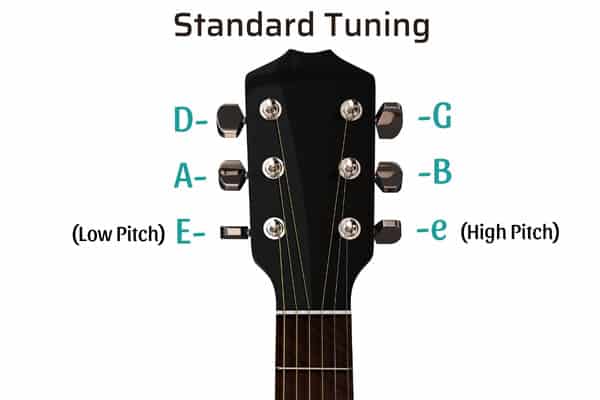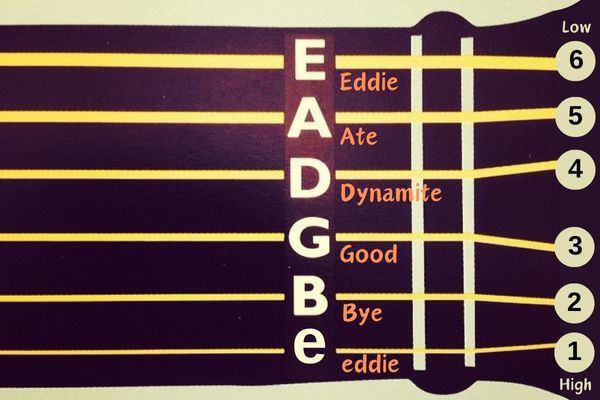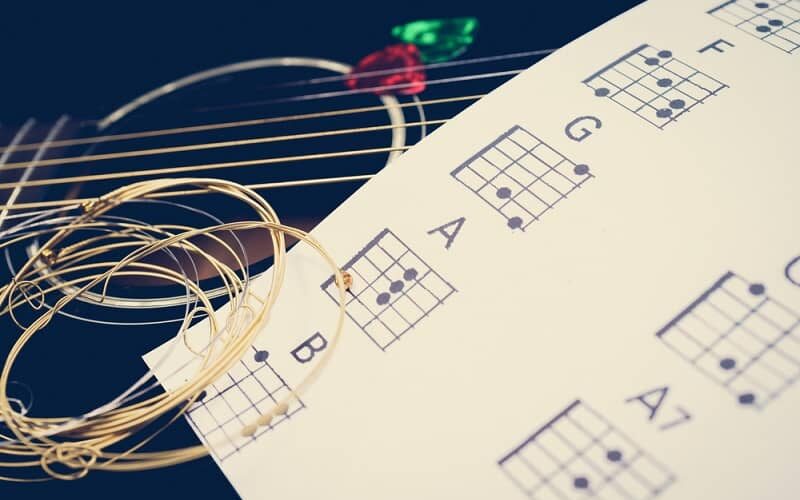If you just started to learn how to play guitar, the names of the notes and tuning of the strings can seem a little daunting. There are a few tips and tricks to remember them but the best thing is to get a better understanding of the notes themselves.
Once you understand some basic music theory it will not be so hard to memorize certain aspects. Here are some ways to learn and remember your guitar string notes.
The Notes and Their Intervals
In Western music traditions, our note alphabet consists of A-G, with flats or sharps occurring between some of them, resulting in a total of 12 notes. All of the genres like pop, rock, dance, metal, and funk you hear will usually consist of those notes.
The spacing or interval of these notes determines their final vibe or emotion. Two notes that are a minor 2nd apart are sad or scary, while a perfect 5th sounds strong and powerful.
As we start to put more than two notes together they continue with these sonic qualities. Knowing how these intervals, guitar scales, guitar chords, and chord progressions sound are important to being a well-rounded player.
It’s the same as if you were a cook or baker, there are certain ingredients that create popular foods, and understanding the recipe will make you better at that skill.
You can actually tune your guitar any way you want with any combination of those 12 notes but you may not like what you hear. The guitar is a chordophone which means we are strumming multiple notes at a time to form a chord so it is essential that we press down on the right combinations of notes.
Imagine if you just smashed your hands down on many random piano keys how jarring it would sound. The same thing goes for guitar, we need a tuning that will be convenient to play in with no harsh sounds. So go to your favorite guitar tuner online and let’s dive in!
Standard Guitar Tuning
The modern standard guitar tuning is EADGBE or EADGBe (a lowercase e to notate a higher octave) but it wasn’t always that way. Stringed instruments in the past were often tuned in a perfect 5th as that sounded great and provided easy patterns for the music of that era.

However, as time progressed popular music began changing and its patterns, scales, and chord progressions became harder to form chords with, so people started using all 4th intervals instead of the 5th. This is even a great primer to start learning your guitar fretboard notes.
That is obvious with E-A, A-D, D-G, and B-E those are all a fourth in distance, but the G-B is a third apart which often confuses new players! Why didn’t they make it all fourths?
There actually is a tuning for that but it makes it harder to form many of the popular chords we need for most songs. The reason the guitar was the peak of 20th century music is that it was literally adapted to be the perfect vehicle for pop, rock, and dance.
This mixture of mostly 4th intervals with one 3rd is why patterns and scales on the guitar are so wonky. Some guitarists like to change the tuning so their soloing or improvising is easier but it’s best not to do this at first.
As a beginner stick to the standard guitar tuning and learn the chord shapes before trying new ones. And most of all before learning a new tuning make sure you have memorized EADGBE first!
How to Memorize Standard Tuning
First of all, it is not a requirement to memorize how to tune your guitar in order to play it. Even top-tier pros use pedal or clip-on tuners every single time.
Having your guitar correctly in tune is more important than being able to say you can do it by memorization. But unfortunately, sometimes you don’t have a tuner to work with, so here’s how to tune a guitar.

People often love mnemonic devices to memorize and standard tuning has many. The classic is:
“Eddie Ate Dynamite Good Bye Eddie”
There are many variations on these and some are NSFW but if they help you memorize the tuning then great!
However, there are many better ways to learn the notes of the strings and the notes on the fretboard.
- Compare each note to the piano, starting at E2 or the second E note on the keyboard and the high e string will be E4 on the piano. Find all your open strings and any other notes. You can also compare your guitar notes to other instruments. This is one of the best ways to train your ears by comparing sounds.
- Anytime you practice a song, break it down and look closely at its chords, melody, and any of the notes. This can be tedious but it is great practice to deconstruct the music that you like and play.
- Barre chords and scales will help you see the patterns and intervals on the fretboard better, learn as many as you can and the bigger picture will start to emerge.
- Play the strings down and then up and say out loud E-A-D-G-B-E and E-B-G-D-A-E for each string, do this at least 7 times out loud to help solidify it in your memory.
Now it may seem like the easiest way is a mnemonic device or a quick memory trick but in reality, those do not really stick in your brain well. The best way to learn music is to engage and actively do it, forget about remembering everything, and just listen and copy.
Initially, this will be frustrating and annoying and you will surely think there is a better way! But there isn’t. You must study intervals, scales, chords, and play as many songs as possible to get to your goal.
Once you start getting a handle on standard tuning of EADGBE and have some easy guitar songs under your belt you can try other tunings like open G or DGDGBD.
Remember we changed the spacing of the notes so the chords and overall vibe will be different. Like other music aspects, this will be hard but with each practice your muscle memory will take over and memory will not be such an issue!
To be clear there are many famous guitarists in the past 100 years who never had proper teachers or guitar lessons and they just figured it out. Some used blues tunings, folk tunings, or even more classical approaches.
They used their ears to find the right intervals and simply tried to mimic the world they heard. And many were phenomenal players, so don’t sweat it if you struggle with memorization, just keep practicing what you like.
You can use mnemonic devices to remember standard guitar tuning or you can dissect your scales and chords to learn your string notes. As always, regular playing of songs, riffs, tabs, and solos of different genres will be the best help.
Take your time and stick to music that matches your current skill level. With consistent practice, musical memory will naturally develop. New music students often overthink the emotional aspect of playing, but in reality, a balance of music theory knowledge and ample practice is all that’s required.
About the Author
Throughout Gary's career, from School of Rock, to Public School Modern Band Teacher, to Director of Curriculum at Little Kids Rock, there has been one single mission - to empower students to discover, play, and create music on their own terms. His role is simply to be the best guide he can be.



As a beginner, this article was a lifesaver! The tips and techniques for memorizing string note names were simple yet effective. Following the advice has made my practice sessions much smoother.